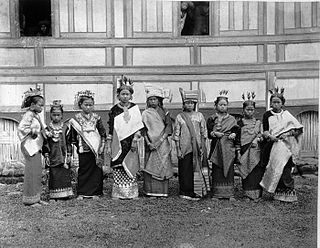 W
WAdat is the generic term derived from Arabic language for describing a variety of local customary practices and tradition as observed by Muslim communities in North Caucasus, Central Asia and Southeast Asia. Despite its Arabic origin, the term adat resonates deeply throughout the Maritime Southeast Asia, where due to colonial influence, its usage has been systematically institutionalised into various non-Muslim communities. Within the region, the term refers, in a broader sense, to the customary norms, rules, interdictions, and injunctions that guide individual's conduct as a member of the community and the sanctions and forms of address by which these norms and rules, are upheld. Adat also include the set of local and traditional laws and dispute resolution systems by which society was regulated.
 W
WAdat Perpatih are customary laws which originated from the Minangkabau Highlands in Sumatra, Indonesia. It was found by a Minangkabau leader named Sutan Balun or more famously known as Dato Perpatih Nan Sebatang. In Malaysia, Adat Perpatih is a combination of practices and rules of life for the Minangkabau people and other aborigins such as Semang, Temuan people, the Bersisi and the Jakun people that were mainly farmers at that time. Over time, this custom is practiced by many other ethnics including part of Malacca in particular of Masjid Tanah and part of Johor.
 W
WAlfur, Alfurs, Alfuros, Alfures, Alifuru or Horaforas people is a broad term recorded at the time of the Portuguese seaborne empire to refer all the non-Muslim, non-Christian peoples living in inaccessible areas of the interior in the eastern portion of Maritime Southeast Asia.
 W
WBaju Kurung is a traditional costume originated from Sumatra, and Malay peninsula, and is traditionally worn by women in Brunei, Indonesia, Malaysia, Singapore and southern Thailand. This type of traditional costume is the national dress of Brunei and Malaysia. In Indonesia, it is also one of the regional dresses, seen most on the island of Sumatra, where many ethnic Malay and Minangkabau women wear it.
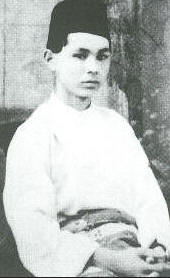 W
WBaju Melayu is a traditional Malay costume, originated from the court of Malacca, and is traditionally worn by men in Brunei, Malaysia, Singapore, parts of Indonesia, southern Philippines, and southern Thailand. It literally translates as Malay dress and consists of two main parts. The first being the baju itself which has a raised stiff collar known as the cekak musang collar. The second part is the trousers called seluar. The two parts are made out of the same type of fabric which is usually cotton, or a mixture of polyester and cotton. A skirt-type adornment is also commonly worn with the Baju Melayu, which is either the kain samping, made out of songket, tenun cloth or the kain sarung, made out of cotton or a polyester mix. Both are loops of fabric that are folded around the wearer's waist. A jet-black or dark-colored headgear called the songkok can also worn to complete the attire.
 W
WBangsawan is a type of traditional Malay opera or theatre performed by a troupe, and accompanied by music and sometimes dances. The bangsawan theatrical performance encompasses music, dance and drama. It is widely spread in the Malay cultural realm in Malaysia, Indonesia, Singapore and Brunei. The artform is indigenous in Malay Peninsula, Riau Islands, Sumatra and coastal Borneo.
 W
WBendahara is an administrative position within classical Malay kingdoms comparable to a vizier before the intervention of European powers during the 19th century. A bendahara was appointed by a sultan and was a hereditary post. The bendahara and the sultan shared the same lineage.
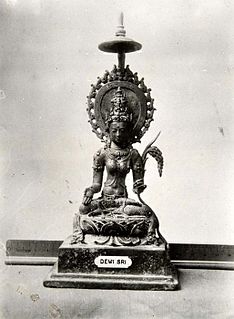 W
WA bomoh is a Malay shaman and traditional medicine practitioner. The term is used mainly in Malaysia and parts of Sumatra, whereas most Indonesians use the word dukun. It is often mistranslated into English as medicine man or witch doctor. In colloquial usage, the term bomoh is often interchangeable with another type of shaman, the pawang, but they generally serve different functions. The bomoh is primarily a healer, herbalist, geomancer, and sorcerer. The pawang on the other hand usually specialises in rituals involving weather, nature, animals, and a good harvest. Their roles do overlap however, and both act as an intermediary for the spirits and gods.
 W
WBongai also known as Rentak Kuda, is a traditional folk song of Negeri Sembilan. It can be sung as solo, duet or in a group with or without accompanied by musical ensemble.
 W
WBoria is a form of Malay theatre of Indian origin which has through adaptive processes, become the one and only theatre of Malay community in Penang, Malaysia
 W
WThe Burung Petala Processions referred to a series of imperial parade to commemorate the circumcision ceremony of the Kelantanese nobility. During the grand cavalcade, the prince and his royal entourage were celebrated around Kota Bharu via a large bird-like processional cart, notably the grand chariot of 1933 known as Burung Petala Indra and tandu Burung Petalawati of 1923. The processions were held three times between 1919 and 1933.
 W
WMalay cuisine is the cooking tradition of ethnic Malays of Southeast Asia, residing in modern-day Malaysia, Indonesia, Singapore, Brunei, Southern Thailand and the Philippines as well as in Cocos Islands, Sri Lanka and South Africa. Different Malay regions are all known for their unique or signature dishes—Pattani, Terengganu and Kelantan for their nasi dagang, nasi kerabu and keropok lekor; Pahang and Perak for its durian-based cuisine, gulai tempoyak; Kedah and Penang for their northern-style asam laksa and rojak; Satun and Perlis for its bunga kuda dessert; Negeri Sembilan for its lemak-based dishes; Malacca for their spicy cincalok; Singapore for their rojak bandung and roti prata; Riau for its ikan patin dishes, gulai ikan patin and asam pedas ikan patin; the Riau Islands for their sup ikan; West Sumatra for its rendang and lemang; Deli Malays of North Sumatra for their nasi goreng teri medan and gulai ketam; Jambi for its ikan mas panggang and tempoyak; Palembangese Malays of South Sumatra for their pempek, mi celor and nasi minyak; Bangka Belitung for its siput gonggong and terang bulan; West Kalimantan and Sarawak for its bubur pedas and ayam pansuh; Brunei for their nasi katok and unique ambuyat dish; Sri Lankan Malays of Sri Lanka for its kalu dodol and watalappam; and Cape Malays of South Africa for their bobotie, boeber and koe'sister.
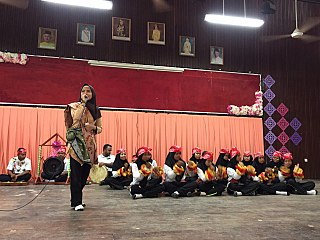 W
WDikir barat is a musical form, native to the Malay Peninsula, that involves singing in groups—often in a competitive setting. Dikir barat may be performed either with a percussion instrumental accompaniment, or with no instruments at all. The dance is partially similar in movement to Endang except that actions of hand clapping are further incorporated to produce rhythm. The origins of dikir barat are unclear; it is found in both Malaysia and Thailand, and today the Malaysia National Department for Culture and Arts actively promotes it as an important part of Malaysian national culture.
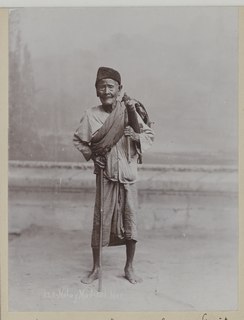 W
WMalay folklore refers to a series of knowledge, traditions and taboos that have been passed down through many generations in oral, written and symbolic forms among the indigenous populations of Maritime Southeast Asia (Nusantara). They include among others, themes and subject matter related to the indigenous knowledge of the ethnic Malays and related ethnic groups within the region.
 W
WThere are many Malay ghost myths, remnants of old animist beliefs that have been shaped by Hindu-Buddhist cosmology and later Muslim influences, in the modern states of Brunei, Indonesia, Malaysia, Singapore and among the Malay diaspora in neighbouring Southeast Asian countries. The general word for ghost is hantu, of which there exist a wide variety. Some ghost concepts such as the female vampires pontianak and penanggal are shared throughout the region. While traditional belief doesn't consider all ghosts as necessarily evil, Malaysian popular culture tends to categorise them all as types of evil djinn.
 W
WA green envelope is a Malay adaptation of the Chinese red envelope custom. During the festival of Eid ul-Fitr, Muslims in Malaysia, Brunei, Singapore, and Indonesia hand out money in green envelopes to guests who visit their homes. The colour green was chosen for its association with the Islamic paradise. The idea of handing out green envelopes is based on the Islamic concept of zakat, where every Muslim is required to provide at least 2.5% of their wealth to the needy. However, Malays now hand out these green envelopes during Aidilfitri not only to their poor guests, but also to the middle class and to the upper class. The amount of money depends on how much the host can afford to give their guests.
 W
WHang Jebat was the closest companion of the legendary Malaccan hero Hang Tuah. Regarded in Malaysia as one of the greatest silat exponents in history, he is well known for his vengeful rebellion against the Malacca Sultan whom he served. He can also be regarded as an early Malay anarchist following his rebellion against the ruler.
 W
WHang Tuah was a warrior who lived in Malacca during the reign of Sultan Mansur Shah in the 15th century. He was supposedly the most powerful of all the laksamana, or admirals, and is considered by the Malays to be one of history's greatest silat masters. Hang Tuah is held in the highest regard, even in present-day Malay culture, and is arguably the most well-known and illustrious warrior figure in Malay history and literature.
 W
WIstinggar is a type of matchlock firearm built by the various ethnic groups of the Nusantara archipelago of Indonesia. The firearm is a result of Portuguese influence on local weaponry, particularly after the capture of Malacca (1511). Before this type of gun, in the archipelago already existed primitive long gun called bedil, or Java arquebus as the Chinese call it.
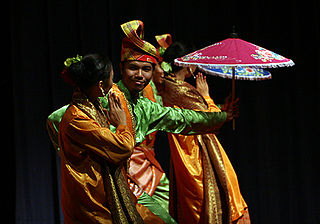 W
WJoget is a traditional Malay dance that originated in Malacca. It was influenced by the Portuguese dance of Branyo which is believed to have been spread to Malacca during the spice trade. In Malacca, it is better known as Chakunchak. The dance is one of the most popular folk dances in Malaysia and normally performed by couples in cultural festivals, weddings and other social functions. Joget also grew in popularity within the Malay community in Singapore after its introduction in 1942.
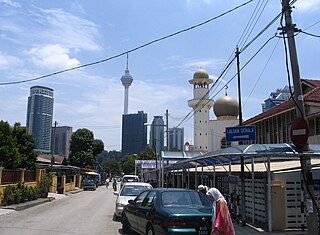 W
WKampung Baru or "Kampong Bharu" is a Malay enclave in central Kuala Lumpur, Malaysia. One of the most valuable tracts of land in the capital, it has been estimated to be worth up to US$1.4 billion. Kampung Baru's elders have turned developers away, saying they want to preserve their ethnic Malay lifestyle.
 W
WKemben is an Indonesian female torso wrap historically common in Java and Bali. It is made by wrapping a piece of kain (clothes), either plain, batik printed, velvet, or any type of fabrics, covering the chest wrapped around the woman's torso.
 W
WMak Yong is a traditional form of dance-drama from northern Malaysia, particularly the state of Kelantan. It was banned by the Pan-Malaysian Islamic Party because of its animist and Hindu-Buddhist roots which pre-date Islam in the Asian region by far. The late Cik Ning was a leading Mak Yong performer in the 1980s. In 2005, UNESCO declared Mak Yong theatre a "Masterpieces of the Oral and Intangible Heritage of Humanity".
 W
WThe Malay gamelan is a style of music originated from Indonesia, performed in Malay-populated regions of Indonesia and Malaysia as well.
 W
WMalay houses are traditional dwellings, originating before the arrival of foreign or modern influences, and constructed by the indigenous ethnic Malay of the Sumatra, Borneo and Malay Peninsula.
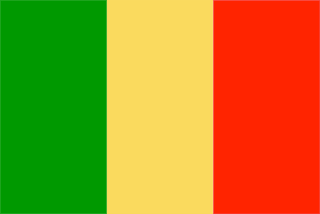 W
WA tricolour featuring green, yellow and red, is a combination of colours that commonly found in varying designs of symbols adopted by some major organisations to symbolise the Malay people.
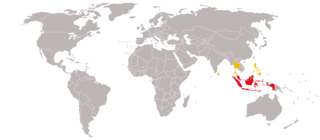 W
WThe Malay world or Malay realm, is a concept or an expression that has been utilised by different authors and groups over time to denote several different notions, derived from varied interpretations of Malayness, either as a racial category, as a linguistic group or as a political-cultural group. The use of the term 'Malay' in much of the conceptualisation is largely based on the prevalent Malay cultural influence, manifested in particular through the spread of the Malay language in Southeast Asia as observed by different colonial powers during the Age of Discovery.
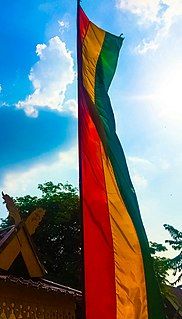 W
WMalayisation or Malayization is a process of assimilation and acculturation, that involves acquisition or imposition of elements of Malay culture, in particular, Islam and the Malay language, as experienced by non-Malay populations of territories fully controlled or partially influenced by historical Malay sultanates and modern Malay-speaking countries. It is often described as a process of civilisational expansion, drawing a wide range of indigenous peoples into the Muslim, Malay-speaking polities of Maritime Southeast Asia. Examples of Malayisation have occurred throughout Asia including in Brunei, Cambodia, Indonesia, Malaysia, Singapore, and Sri Lanka.
 W
WMiniature meriam kecil is a type of very small cannon found on the Indonesian archipelago. Usually the length of these cannons is between 10 to 60 cm, with a caliber of 15 or 16 mm, and has been around for hundreds of years. They are designed and decorated like a normal sized meriam kecil.
 W
WPayung dance is a folk dance-drama tradition of Minangkabau-Malay ethnic group in Sumatra, Indonesia. This dance is belong to Minangkabau version of Malay dances in Sumatra. Folk theatre such as toneel and sandiwara often performs payung dance as a part of the show. Payung (umbrella) is a main instrument of this dance. Payung dance symbolized affection and relationship of young people that usually performed by three or four dancers in a performance. This dance is originated from West Sumatra, Indonesia.
 W
WPeranakan beaded slippers, also known as Kasut Manik, literally meaning "beaded shoes", is a type of shoe that dates back to the early twentieth century Malaya. It refers to beaded slippers worn by a nyonya to complete her Sarong Kebaya outfit, together with chained brooches (kerosang) and a silver belt. The slippers are made of Peranakan cut beads, which are treasured as these beads are no longer available. Vintage Kasut Maniks are intricate and finely stitched, a testimony to the fine workmanship of yesteryears. The intricacy and fine workmanship of a pair of the beaded slipper is also a hallmark of highly accomplished Peranakan women, also known as Nyonya, whose skills in embroidery and beadwork are highly valued.
 W
WIn Chinese and other East and Southeast Asian societies, a red envelope, red packet or red pocket is a monetary gift which is given during holidays or special occasions such as weddings, graduation or the birth of a baby.
 W
WRodat is an Indonesian folk dance believed to have originated from the Middle East and was spread to the Indonesian archipelago by the Acehnese traders in the beginning of 19th century. Rodat may have been the combination of two words hadrat Baghdad which means zikir Baghdad.
 W
WRonggeng is a type of Javanese dance in which couples exchange poetic verses as they dance to the music of a rebab or violin and a gong. Ronggeng might have originated from Java in Indonesia.
 W
WSepak takraw, or kick volleyball, is a sport native to Southeast Asia. Sepak takraw differs from the similar sport of footvolley in its use of a rattan ball and only allowing players to use their feet, knee, and head to touch the ball.
 W
WSilat Melayu, also known as Seni Persilatan Melayu or simply Silat, is a combative art of self-defence from the Malay world, that employs langkah ('steps') and jurus ('movements') to ward off or to strike assaults, either with or without weapons. Silat traced its origin to the early days of Malay civilisation, and has since developed into a fine tradition of physical and spiritual training that embodies aspects of traditional Malay attire, performing art and adat. The philosophical foundation of modern Malay Silat is largely based on the Islamic spirituality. Its moves and shapes are rooted from the basis of Silat movements called Bunga Silat, and Silat performances are normally accompanied with Malay drum assembles.
 W
WSoutheast Asian mancalas are a subtype of mancala games predominantly found in Southeast Asia. They are known as congklak, congkak, congka, and dakon in Indonesia, congkak in Malaysia and Brunei, and sungkâ in the Philippines. They differ from other mancala games in that the player's store is included in the placing of the seeds. Like other mancalas, they vary widely in terms of the rules and number of holes used.
 W
WTaming Sari is a famous kris in Malay folklore. It is believed to have been wielded by the legendary Malaccan warrior Hang Tuah, and is fabled to grant physical invulnerability to its wielder.
 W
WTempoyak or asam durian is a Malay condiment made from fermented durian. It is usually consumed by the ethnic Malays in Maritime Southeast Asia, notably in Indonesia and Malaysia. Tempoyak is made by taking the flesh of durian and mixing it with some salt and kept in room temperature for three or five days for fermentation. Tempoyaks are usually made during the durian season, when the abundance of durian and excess production are made into fermented tempoyak.
 W
WTudong is a Malay word, literally meaning the noun "cover", which is commonly translated/referred to as veil or headscarf in English.
 W
WUlek Mayang is a classical Malay dance from the state of Terengganu in Malaysia.It is a ritualistic dance performed to appease or invoke the spirits of the sea and is always accompanied by a unique song also called Ulek Mayang. An orchestra comprising drums, gong, violin and accordion accompanies the dance.
 W
WWau bulan is an intricately designed Malaysian moon-kite that is traditionally flown in the Malaysian state of Kelantan. It is one of Malaysia's national symbols, some others being the hibiscus. The reverse side of the fifty-cent coin of Malaysia features an intricately decorated wau bulan with a hummer on top. The logo of Malaysia Airlines (MAS) is based on the wau kucing.
 W
WZapin is of the most popular dance and musical forms in traditional Malay performing arts. Elegant dance movements are choreographed to the lively melodies, which are performed using musical instruments such as the gambus, accordion and rebana. It is believed to have been introduced by Persians and Arabs Muslim missionaries from the Middle East to Malay Archipelago around the fourteenth century where back then only males were allowed to perform; nowadays, female dancers are included. It used to be performed exclusively for religious ceremonies but through the years it has become a form of traditional entertainment, hence the participation of female dancers is allowed.
 W
WZapin Api is a firedance technique of the classical Malay Zapin founded in Pulau Rupat Utara, Bengkalis, Riau, Indonesia. The identifying characteristic of Zapin Api is the incorporation of fire and strong focus on the mystical elements. The dance form was historically dormant and extinct for nearly 40 years before its revival in 2013.